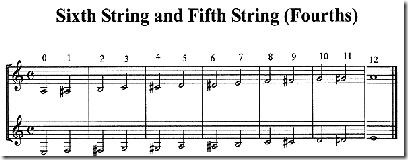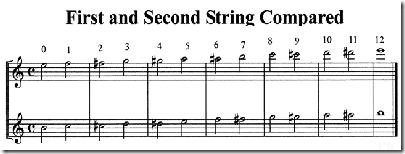As we discussed last session in PART TWO, the guitar neck holds a dark, dangerous 'Mystery Zone' for many players. This Mystery Zone extends form the fifth fret to the twelfth fret. Hey, we all know that the guitar neck is fretted in half steps. Well, the neck is fretted in half steps and the strings (for the most part) are arranged in fourths. Knowing this, we can assume that certain pitches will fall on certain strings and frets. And we'd be right. And we forget this the minute we try to read a piece of music that will require us to play at the seventh fret and up. Let's explore and take that mystery out of the Mystery Zone. Okay?
Now let's assume that you have learned his Grand Barre chord based on the E major open position chord -- the Barre chord that makes an F major at the first fret, a G major at the third fret, an A major at the fifth fret and so on. Here's the point. If you knows this chord and can use it to generate chords up and down the neck, you already knows the pitch names of the notes of the sixth string. See the following example. You may not have realized that these pitch names were notated as follows, but now you sure do! It is always said that if you can tune your guitar to itself using the fifth fret/open string method, then you already know the notes of the fifth fret across the neck. See the A note on the fifth fret in the diagram? That's the A open string note as well -- notation-wise as well as pitch-wise.
Guess what? If you know the notes of the sixth string, well, the first string is a gimmee. Of course, it will be notated two octaves above the sixth string... See the example
So by looking at these two examples, you can see that you know way more notes than at first thought. "But," you may ask, "I can't read the strings in between! What do I do?" As mentioned above, for the most part, the guitar is tuned in fourths.
"But, but, but..." I can hear the stammering complaints now. "There's only an interval of a third between the third (G) string and the second (B) string!!! Ha, ha, gotcha!" Back off, Einstein. Sure, but the second string is a fourth below the first string! So the principle can still be used. See the next example. Once again, the old tuning concept comes up -- the fifth fret note on the second string is the same as the open first string, both an E, both notated in the top space of the staff.
Look at that! In a few short paragraphs you can now read four strings with a small degree of confidence. Next session we'll look at the fourth and third string and tie the whole neck together through the knowledge of intervals. It really does all make sense!














No comments:
Post a Comment